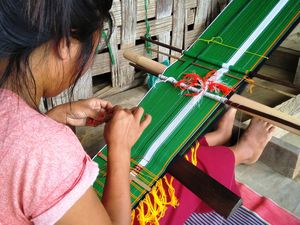Even as the video of two stripped-bare women from Manipur went viral, one is reminded again of how wars are constantly fought by men abusing the bodies of women. Rape and sexual violence is a centuries-old war crime, the conflict between men is always played out on its women, too.
Women are, after all, male terrain. You win over a king, a tribe, a country, by shaming and taking over its women. The two women were humiliated through nakedness, even as more stories of rapes are emerging.
The irony is not to be missed. Women are part of dressing the community in the northeast. Unlike the rest of India, women of this region are the main weavers of cloth. Arunachal Pradesh, Assam and Manipur famously wear garments made by women bending over the loin loom. It is much smaller, hence easy to keep at home, and still a popular activity for local women regardless of there being zero interest in their traditional cultures outside their tribes. I mean, imagine if only Benarasis wore the dazzling Benaras saris, or if only women of Madhya Pradesh wore the chanderi. We would all be poorer for it, not just the weavers of the cloth.
Manipuri textiles do not compare in allure, but they certainly do in craft techniques and heritage narratives. The arts and crafts of Manipur provide for a fascinating study of tribal culture. This is also seen in the Chin-Kuki-Mizo tribes—ethnic tribes that live in six of the seven northeastern states, the exception being Arunachal Pradesh. They are called the Mizo in Mizoram, and the Chin in Myanmar. Art and craft is how they dress, build their homes, household items and make jewellery from.
The clothing of this region is extremely significant in storytelling—each motif, colour and shape speaks of one’s place in society. It is like one’s entire biography is told in a skirt or a jacket. Carolyn Niengneihmoi, a research scholar from Manipur University, says: “Dresses are the identity of every nation or tribe. For the Chin-Kuki-Mizo, dresses are the unwritten constitution. It is a symbol whereby a man’s social status and culture can be determined. Every shawl and loincloth is patterned with beautiful designs and chequered with different colours, which have immense cultural significance.”
Manipur is an extraordinarily beautiful land, surrounded by blue hills and nestled in an emerald carpet. Its dominant tribe is the Hindu Meitei, living in the valleys, whereas the Kukis live in the hills. The Meitei costumes are the innaphi, or the diaphanous dupatta ‘wrapper’, and the phanek or the sarong. The innaphis used to be made of coarse bark, but richer families make intricately designed ones in silk and cotton. It is very similar to the Bengal muslin, or the gossamer jamdani.
The Kukis are largely Christian, thanks to the missionaries during the British Raj. The Kuki women wear a knee-length ponve, a sarong that is wrapped above their breast and down to their knees. The tuck is famously under the left arm. A petticoat, called the nih, is made of red and black stripes and is strung at the waist.
The missionaries also introduced the Kukis to English, which modernised them in some ways. The community has a custom of Lawm, where boys and girls learn hunting and farming, as well as javelin, high jump and shot put.
Like much of rural India, weaving in Manipur has taken a huge beating. It is now a leisure activity, and lack of marketing has made traditional clothes worn only during rituals and festivities. The civil strife will only push the marginalised into further poverty.
@namratazakaria


